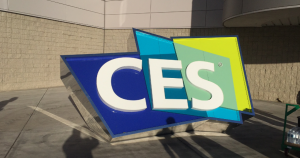901 Tower Drive • Suite 420 •
Troy, Michigan 48098
• P: 248.269.1122 •
E: bianchipr@bianchipr.com
901 Tower Drive • Suite 420 •
Troy, Michigan 48098
• P: 248.269.1122 •
E: bianchipr@bianchipr.com
 Guest post by Mark Kerney of Structural Images
Guest post by Mark Kerney of Structural Images
Mark Kerney has been in the exhibit business for over 35 years and was one of original founders of the company in 1997: “Structural Images is a design / build exhibit house that works with clients from concept to final installation. We create unique one-off 3-D exhibit environments and displays. Operating out of a 43,000 sq. ft. facility in Wixom MI, we provide turn-key solutions for permanent installations, direct-to-client meetings, as well as shows and events worldwide. Our goal is to provide a stress-free experience for our clients.”
Once you have decided to exhibit at CES, the next step is deciding how you will showcase your image, brand and products. Gaining media exposure at the world’s largest B2B tradeshow is important and the design of your exhibit can help you gain that exposure. From initial concept to final installation at the show site, it is an interactive process, which consumes a great deal of time and resources.
 Below are 5 steps on how to plan your CES exhibit to gain maximum exposure:
Below are 5 steps on how to plan your CES exhibit to gain maximum exposure:
1. Hold an internal meeting. The first step in planning your CES exhibit is to hold an internal client meeting with all stakeholders. Here, your team will decide which messages, products and graphics should be incorporated within the design concepts. Determine how many staff members will be working the booth at any given time. Discuss the need for private and semi-private meeting space. Agree on what you, as a group, recommend from previous trade show experiences. Decide if any current display properties should be incorporated in the new design. Determine who will be the point of contact within your organization to communicate with the exhibit house. Agree on a budget for the design / build portion and separate on-site budget. Create a timeline to keep things on-track.
2. Meet with the exhibit house team. Meet with your exhibit house team to review your booth and on-site services package with the exhibit house. Specific items that should be reviewed are:
• Booth location, size and rules related to that specific booth space (i.e. island, peninsula, in-line)
• Traffic flow and viewing angles
• Overhead signs and lighting options
• Features and benefits that make your company stand out and what your customer base expects
• Corporate standard graphic package
• Booth requirements, including reception counter, meeting space, storage space, product displays and graphics
Be sure to educate the exhibit house team on all of the products and / or services you want to show, including any existing displays to be incorporated in the design. Also, share your corporate standard graphics package with the design team.
While reviewing all these items, remember to allow the exhibit house three to four weeks to provide initial concepts and preliminary pricing.
3. Create exhibit content. Prepare all relevant content (i.e. product, graphic and photographic information) for your exhibit house, and establish separate timelines for graphics, product displays and overall architectural elements. With a crowded calendar, it may be helpful to schedule separate product team meetings to review product displays and discuss any necessary changes while in production. In this stage, communication is essential and providing feedback will ensure that all team members are on the same page. Remember that building a custom exhibit is like building prototypes. . . you may have whatever you desire, if you remain engaged throughout the process and provide necessary direction as needed.
4. Remember exhibition site deadlines. Once the exhibit content is created, it is time to move to the site. As with anything, planning is important for the pre-show. Such planning can save you time and money. At this point, be mindful of all the deadlines the tradespeople and on-site services have. If you miss any deadlines, you can expect to pay late fees as high as 30 percent or more. Also, pay attention to deadline for booth layout approvals. Drawings of the booth showing elevation views, floor plan options, electrical, hanging sign and structural elements need to be submitted and approved months in advance.
5. Review exhibit with your team. Invite your team that will work the show to review the booth at the exhibit house prior to shipping to familiarize them with the properties and engage them early. Plan to review the following in your final walk-through meeting:
• Booth space and placement of display properties within exhibit
• Videos, touchscreens and iPads
• Content (giveaways, literature, refreshments, etc.) that you want in the exhibit to be packed with the display shipment
Ultimately, careful planning and managing of the details throughout the process will help you to have a successful CES exhibitor experience.
For more detailed insight on an exhibit house that has helped many exhibitors maximize their CES presence, visit http://structuralimages.com/ or email: info@structuralimages.com.
You might also be interested in:
One Trackback